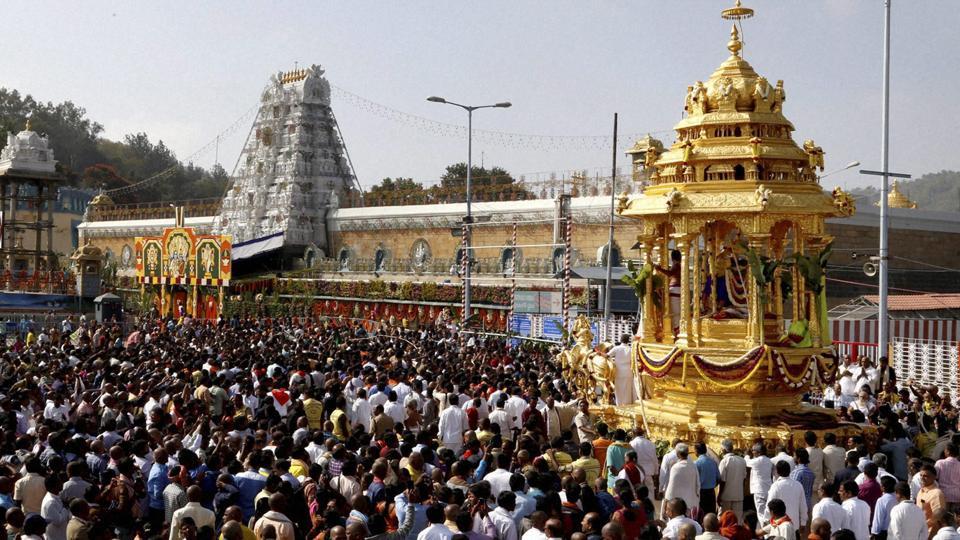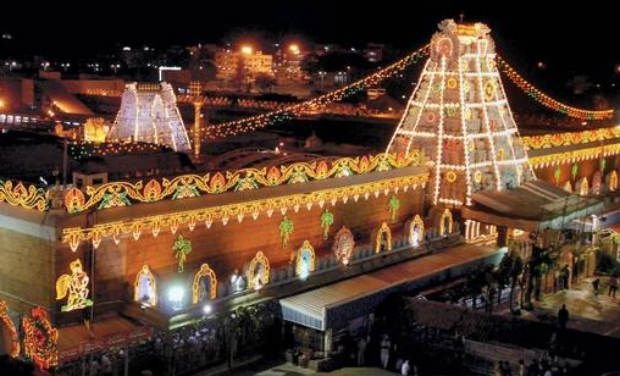TIRUMALA - THE ABODE OF LORD VENKATESWARA
Venkatadri samam sthanam brahmande nasti kinchana
Venkatesa samo devo na bhuto na bhavishyati.
Picturesquely situated on the top of the hills, Tirumala -the abode of Lord Venkateswara, is reputed as the most ancient temple in India, Sastras, Puranas, Sthala Mahatmyarns, and Alwar hymns, unequivo cally declare that in the Kali Yuga one can attain mukti only through worshipping this Venkata Nayaka or Lord Venkateswara.
To illustrate that Venkatadri is unique in its sacredness it is enough to point out that Sri Ramanuja, the great Sri Vaishnava Acharya, ascended Tirumala on his knees as he thought it sacrilegious to climb on foot the Hills on which the Lord rested.
HISTORY
Ample epigraphic testimony about the antiquity of the temple is available and has been collected and published by the Tirumala Tirupati Devasthanams (TTD) The temple itself is believed to have I existed from very ancient times and it is said that Sri Venkateswara is referred to even inthe Rigveda.
‘Sri Venkatachala Mahatrnyam’ contains Puranic lores from the twelve Mahapuranas. The puranic legends say that after the Pralaya kalpa preceding the great Deluge, the Supreme Being Maha Vishnu, revealed Himself in the form of a White Boar, Sweta Varaha, rescued the earth and recreated it and having re-established the universe, He decided to stay on the earth for some time to protect the good and destroy the evil. Thus God Vishnu revealed Himself earlier. in the previous incarnation as Varahaswami on the bank of the Varaha Tirumala i.e. northern portion of Pushkarini at Tirumala. This manifestation as the White Boar is enshrined in the Adi Varahaswami temple on the north western bank ofthe Pushkarini at Tirumala_ This temple is believed to be older than the temple of Lord Venkateswara and claims precedence in worship and Nivedana.
There are many more legends about the Venkatachala Hill and Lord Ven kateswara in the Varaha and Bhavishyottara Puranas. The meritorious benefits acquired by a pilgrimage to Venkatachala are mention in the Puranas and Sri Venkateswara is described as the great giver of boons.
All the great dynasties of the southern peninsula had paid their tribute to this ancient shrine. The Pailavas of Kancheepuram (9th century A.D,), Cholas, Pandyas and the kings, chiefs of /iiayanagar (14th - 15th Century) were ardent ‘devotees of Lord /enkateswara and they vied with each other in endowing the temple with rich offerings and benefactions, lt was during the Viayanagar period the glory of Tirumala reached its pinnacle. The statues of Sri Krishna Devaraya, the illustrious king ofthe Vijayanagara empire and his consorts were installed in the temple at the portals, in his own life-time and they can be seen even today. There are also statues of Achyuta Raya and Venltatapati Raya, Sri Krishna Deva Raya visited the sacred shrine seven times with his consorts during his reign.
Even after the decline of the Vijayanagar dynasty, inspite of the cholas and anarchy that prevailed in the region, the nobles and chieftains from all parts of the country continued paying their homage and gifts to the temple. The Maratta general, Raghoji Bhonsle, visited the temple and set up a permanent endowment for the conduct of worship in the temple, He also presented valuable jewels to the Deity, including the great emerald which is still preserved in a box named after him. Among the later rulers who have endowed large benefactions are the rulers of Mysore and Gadwal.
After the fall of the Hindu kingdoms, the Muslim rulers of Karnataka and the Britishers stepped into their shoes and many of the temples including the temples of Tirumala and Tirupati came under their supervisory and protective control.
ln 1843 when the East India Company divested itself of the direct management of non-Christian places of worship and of native religious institutions, the administration of the shrine of Sri Venkateswara with a number of estates was entrusted to Sri Seva Dossji of the Hathiramji Mutt at Tirumala as Vicharanakarta and for nearly a century, till 1933 the temple was under the administrative charge of the mahants.
ln 1933 by a special Act passed by the Madras Legislature, the Tirumala Tirupati Devasthanams Committee was invested with the powers of administration and control through a Commissioner appointed by the Government of Madras. This committee was assisted by a Religious Advisory Council in regard to religious matters and a Ryots Advisory Council in regard to the management of the estates of the TTD.
Today, T.T.Devasthanams which maintains so many temples and their sub-shrines is a conglomerate of temples brought under the first schedule 2 of the Act 20 of 1987 enacted by Andhra Pradesh Government. lt is managed by a Board of Trustees appointed by the state government. The Executive Officer is the Chief Executive of the administration. He is assisted by two Joint Executive Officers, Financial Advisor and Chief Accounts Officer, Deputy Executive Officers, Chief Vigilance and Security Officer, Conservator of Forests and Chief Engineer in various spheres of activity. Besides, there are other officials like Law Officer, Welfare Officer, Public Relations Officer. Marketing Officer, Educational Officer and others to look after several wings of administration.


.jpg)
Om namo narayanaaya
Downvoting a post can decrease pending rewards and make it less visible. Common reasons:
Submit
Hi! I am a robot. I just upvoted you! I found similar content that readers might be interested in:
http://www.tirumalabalaji.in/p/blog-page.html
Downvoting a post can decrease pending rewards and make it less visible. Common reasons:
Submit